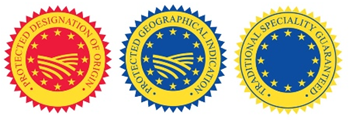
Protect your regional product
Learning about geographical indications
There are many agricultural and food products but also wines that are made in certain regions of the EU that reflect the various traditions and regions of Europe. Think of the ‘Gentse Azalea’ (Ghent azalea), ´Westlandse druif´ (Westland grape) and Champagne. Geographical indications (GI) protect such regional products by adding specific labels. They give clear information about the origin of these products and guarantee customers that the products they buy really come from that specific region, and are not imitation goods.
Discover more about geographical indications in this guide.
Step 1/5 What are geographical indications ?
Geographical indications protect specific regional products, whose qualities are linked to the area where they are produced. They can be considered as quality labels that aim to protect and promote those regional products.
The EU geographical indications system protects the names of products that originate from specific regions and that have specific qualities or enjoy a reputation linked to the area in which they are produced and/or processed.
The EU has two types of geographical indications :
- Protected Designation of Origin (PDO)
- Protected Geographical Indication (PGI)
The difference between PDO and PGI depends primarily on how much of the product’s raw materials must come from the area, or how much of the production process has to take place within the specific region.
Note that next to these geographical indications, the EU also has a specific quality label to highlight the traditional aspects of regional products:
- Traditional Speciality Guaranteed (TSG)
Each of these labels has its own logo to demonstrate that a product has a protected status.

The labels offer consumers clear information about the specific character of the regional product and help ensure fair commercial transactions.
Step 2/5 What is a Protected Designation of Origin ?
The ´Protected Designation of Origin´ label (PDO) is used for agricultural and food products and wines originating in a certain region, but only if the quality or other characteristics of that product can essentially be attributed to the particular geographical environment that exists in the place of origin. Geographical environment covers natural and human factors, such as climate, soil conditions, topography, local know-how, etc. Products bearing this label must be produced, processed and prepared in a certain geographical area, using a recognised and controlled method. For example, cheeses made in a certain area from the milk of a local animal breed, reared in that same geographical area.
Examples: Gorgonzola (cheese), Prosciutto di Parma (ham).
Step 3/5 What is a Protected Geographical Indication ?
The ´Protected Geographical Indication´ label (PGI) is used for agricultural and food products and wines originating in a certain region, provided that the quality, reputation or other characteristics of the product can be attributed to that geographical origin. The conditions for obtaining a PGI are more lenient than those for a PDO. It can be based merely on the product’s reputation of originating in a particular region. Similarly, it is enough for the product to be produced, processed or prepared in that region, not necessarily all three steps combined. The link between the product and its geographical origin is thus weaker than in the case of a PDO. For example, a PGI might apply to hams and sausages that enjoy a certain reputation for being prepared using local methods within a defined geographical area.
Examples: Brussels Grondwitloof (chicory heads), Jambon d'Ardenne (ham), Westland Druif (table grapes).
Step 4/5 What is a Traditional Specialty Guaranteed ?
The term ´Traditional Speciality Guaranteed´ (TSG) highlights traditional aspects, such as the way the product is made or its composition, without being linked to a specific geographical area. The product is considered 'traditional' if it has been sold, unchanged, on the EU market for at least 30 years. Recognition as a TSG can only be requested for food and agricultural products, not for wines, and requires that the product has characteristic features that clearly differentiate it from other foods and agricultural products in the same category. Certain cheeses or specialties that are prepared in a traditional way might qualify, for example.
Examples: Mozzarella (cheese), Kriek (beer), Suikerstroop (sugar syrup)
Step 5/5 How can protection via an EU quality label be obtained ?
To obtain protection through such an EU quality label, the designation of the regional product must be registered with the competent national authority. The application must be submitted by a national group of producers or processors of the product (e.g. an agricultural organisation). To register a designation, your group must submit a file of information on the product that specifies the conditions under which the protected label may be used (geographical delineation, requisite production method, proof of the link between the product’s qualities and a geographical environment, etc.). Keep in mind that quality labels are intended for use by a collective group and not exclusively by a single person or organisation.
Once a geographical indication has been registered, it is protected against unauthorised use and practices that may mislead consumers.
Want to know what to do next or need more information? Our partners can help you!